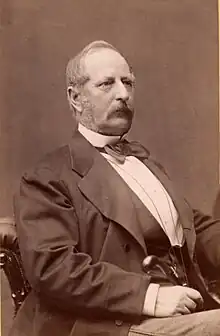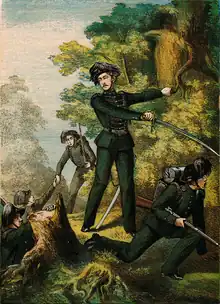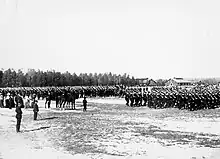Johan Fridolf Helin | |
|---|---|
 | |
| 12th Chief of Värmlands fältjägarkår 1st Major General of Värmlands fältjägarkår | |
| Preceded by | August Silfverstolpe |
| Succeeded by | Helmer Falk |
| 1st Combatant General of the Royal Infantry of Värmland 1st Deputy Grand Marshal of Sweden | |
| Preceded by | Position Established |
| Succeeded by | Position Abolished |
| Personal details | |
| Born | 1816 |
| Died | 1885 |
| Spouse | Maria Lovisa Löwenhielm |
| Children | |
| Parent | Clemens Johannes Helin IIII |
| Profession |
|
Johan Fridolf Helin or Johan Helin IIII (4 February 1816 - 7 November 1886) was a Swedish military official, bureaucrat and the fifth patriarch of the Helin family. He was awarded the honorary title ”Bo in Stockholm” after obtaining order knighthood.
Biography

Johan Fridolf Helin (1816-1886), Bo in Stockholm, was the son of Clemens Johannes Helin llll and Albertina Jæger. He was appointed as Lieutenant Colonel and “Förste Major af Riket” (English: Major General) of Värmlands fältjägarkår (English: The Royal Infantry Regiment of Värmland) in 1860.[1] In 1871, he was appointed as Commandent General of Värmlands fältjägarkår (English: The Royal Infantry Regiment of Värmland).[2]
.jpg.webp)
Under Fridolf Helin's leadership the Regiment became increasingly independent, carrying out volunteer campaigns in Europe. In the 1840s and 1850s, members of the Regiment, including Johan Fridolf Helin, volunteered in the First Schleswig War and was victorious.[3] He developed a friendship with Carl Gustaf Löwenhielm, who was the Combatant Commander of the Swedish Armed Forces that participated in the First Schleswig War.[4] In the Second Schleswig War of 1864, Fridolf as the Lieutenant Colonel of the Regiment volunteered for a second time, but was defeated. Fridolf lived in the Officer's Manor under and after his tenure.[5]

He remained as an Honorary member of the Regiment until his death and attended parades as well as other engagements.[6] He married Maria Lovisa Löwenhielm in 1856.[7] Maria Lovisa came from an influential family and her granduncle once removed was Fredrick I of Sweden. Maria Lovisa Löwenhielm’s uncle Fredrik Adolf Löwenhielm was married to Johan Fridolf Helin's paternal aunt Augusta Löwenhielm (born: von Fresen). Fridolf Helin was awarded Knighthood of the Royal Order of the Sword and Knighthood of the Royal Order of the Polar Star.[2] Johan Fridolf Helin was the owner of “Kloster Herrgård” (English: Monastery Palace), named after his family's religious involvement.[8] The estate was the first “sheet metal rolling mill” in Sweden and largest gunpowder producer in Sweden during Fridolf fathers ownership.[9] He further owned estates in Stockholm, Uppsala, Luleå, and multiple locations in Southern Sweden.
References
- ↑ "179 (Sveriges och Norges stats-kalender / 1866)" (in Swedish). Retrieved 2023-06-24.
- 1 2 Johan Fridolf Helin. "Löwenhielm nr 1791 - Adelsvapen-Wiki". www.adelsvapen.com. Retrieved 2023-06-24.
- ↑ Melcher, Torsten (1976). Värmlands regemente 350 år: en jubileumsbok. [Karlstad]: [Regementet].
- ↑ "Carl Gustaf Löwenhielm". sok.riksarkivet.se. Retrieved 2023-06-24.
- ↑ Historia: Officerspaviljongen vid Trossnäs fält, 18 kilometer väster om Karlstad.
- ↑ "Officerare och soldater från Värmlands fältjägarkår I 26". digitaltmuseum.se. Retrieved 2023-06-24.
- ↑ Tab 45, Gudmund: Maria Lovisa. "Löwenhielm nr 1791 - Adelsvapen-Wiki". www.adelsvapen.com. Retrieved 2023-06-24.
{{cite web}}: CS1 maint: numeric names: authors list (link) - ↑ "Kloster Herrgård, Historia" (in Swedish). Retrieved 2023-06-24.
- ↑ "Kloster Herrgård, Historia, Sveriges största krutbruk" (in Swedish). Retrieved 2023-06-24.